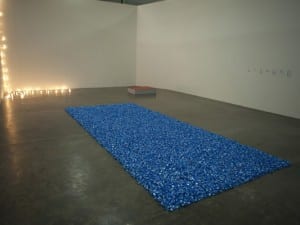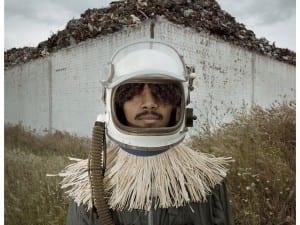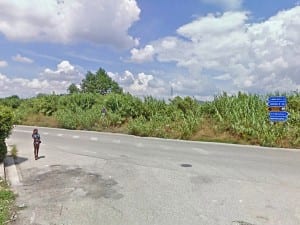Huge, intricate, graphite drawings of suggestive landscapes housing strange architecture… a film weaving together the life of Scottish Psychiatrist RD Laing and the life of the artist himself… a video and sound installation of eerily synced music, sound samples, visuals and archive, and a ritualistic theatrical performance featuring an oracle in the form of a mandrake root plus an inflatable slide. This is The Turner Prize 2012, in the year of royal jubilation, sport spectacle and debt, where all eyes are on London. Expectations, as always, are high as the four finalists’ works are revealed at Tate Britain, London.
First up, Paul Noble and Nobson Newtown (his most well-known creation), an extensively thought-through fictional land, complete with constellations, narratives and bizarrely shaped inhabitants. Large, intricate drawings splay out across the walls here, each stemming from a respective futuristic building built around the letters of a name. There’s an angular building in the shape of the name “Joe” in the largest drawing, and there’s “Paul” himself in the form of a palace in another. Then there’s Trev (the name of the artist’s friend who passed away) surrounded by soft water ripples and containing within it an entire greenhouse of plants beneath a rainbow. Despite the often-poignant elements of Noble’s work, seen particularly in the rain-drenched images for Trev and the ironic failure of the Palace of Paul built on sand, there is also a sense of comedy and playfulness evident throughout whereby the sentimental and symbolic structures are often surrounded by phallic rock-formations and multiple references to sex. This is also continued into the gallery-space where marble sculptures on plinths take the form of awkward and bulbous shapes (described by one of the blushing curators as “sort of excremental”).
Luke Fowler’s photographs hang in the next room, spaced out across the walls leaving plenty of space between each frame. In each set of images, the human protagonist of the first photograph is mirrored in the central object depicted in the second. Colours effortlessly connect subjects together: the dull gold of sunlit skin to the golden grain of pine. Connections are further created in All Divided Selves, a ninety-minute film that explores the life and work of RD Laing, a psychiatrist from the same city as Fowler (Glasgow). Fragments of archival footage of Laing and the artist’s own autobiographical “film notes” weave together, two lives and two different times becoming almost completely merged through a strange and compelling narrative.
Another video-based work resides in a further room of the gallery by Elizabeth Price. Found archival material is presented in a bizarre power point-like manner and images switch between each-other in quick flashes twinned with hand claps and finger-clicks. The subject slowly develops from focussing on architectural plans of churches to footage of girl-bands dancing. The music, sound, image and text begins to gradually split as the whole work crescendos in volume and colour. Eventually, the fragmented elements of the work make no sense alongside each other. Chaos ensues as disembodied pieces of information are flashed in front of the viewer in quick succession. The film ends on footage of the 1979 Manchester Woolworths’ fire and a resolution of sound returning to silence and intermittent claps. Moving seamlessly through calm to chaos to calm again, Price’s work fully envelops the viewer in an often disorientating sensory experience.
A complete contrast to the other artists presents itself in the central space. Wearing odd, hand-painted, almost tribal-like dresses and hoods with only holes for the eyes, Spartacus Chetwynd’s group of performers (the artists’ friends and family) put on a puppet show in a black-and-white-striped room, lit bright green. There’s a small stage at the front made out of cardboard boxes and the puppets sway to the music, telling the story of Jesus and Barabbas. The show ends when the puppeteers move to the side of the room and one (in this instance the artist herself, wearing a beard) removes her hood saying “that’s it. It’s finished.” Another performance then takes place where camouflage-wearing, costumed men worship a deity in the form of a mandrake root (a papier mache mandrake root); the audience are then beckoned forwards and encouraged to lie down prostate beside the oracle mandrake and listen to a fortune. Upon this instance, he mutters “you are a bad liar”; others are told “Beware of Dave” and “You will loose your mobile phone.” An inflatable slide, the entrance way in Chetwynd’s nominated show at the Sadie Coles HQ, is also part of the installation, as well as TV screens showing performances, and prints and cut-outs on the surrounding walls. Chetwynd’s carnivalesque, spectacle feels certainly more free and loose compared with the other more controlled works nominated. As the only performance artist, she has more of a presence (being that she is part of her own work) and seems to emit fun and humour. “It’s about joyful improvisation,” she says. “I think people are embracing performance more now. And, this might sound ridiculous, but I think the reason for this is the apocalypse… that people are somehow now feeling more gestural and manic… and therefore performance is allowed to be the new form of expression that people want.” She laughs.
Considering the sheer diversity between this year’s nominees, deciding the winner of the prize will be no easy feat. However, shadowed by the recent death of jury member Michael Stanley, the Turner Prize, this year, is in mourning and winning does seem somewhat less important. Whether it be Fowles, Price, the more extrovert Spartacus or the quietly comical Noble, the prize will be (although a cliché to say it) well-deserved.
Turner Prize 2012, running until January 9, Tate Britian, Millbank, London SW1P 4RG.
Claire Hazelton
Credits
1. Paul Noble, Public Toilet, 1999, courtesy of Paul Noble / Gagosian, London.
2. Spartacus Chetwynd, Odd Man out 2011, Courtesy the artist and Sadie Coles HQ, London.
3. Elizabeth Price, User Group Disco, 2009, copyright Elizabeth Price, courtesy MOTInternational, London.
4. Spartacus Chetwynd, Odd Man out 2011, Courtesy the artist and Sadie Coles HQ, London.





